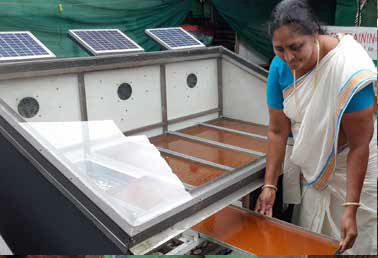
Description of the project: India produces large quantities of fruits and vegetables, but more than 50% of this is wasted. The project aims to: 1) demonstrate the commercial viability of solar drying of fruits, vegetables and condiments, and convert them into profitable products on a micro enterprise scale; 2) equip rural poor women with solar dryers and train them on proper use. Sthree Sakthi Mahila Samajam installed solar powered air dryers in 2017 under the Socio-Economic Program of AIWC. The technology of dehydration gave several benefits such as minimizing food waste and facilitating higher income to rural women. Cereal grains, vegetables, fruits, etc., can be dried in solar dryers under clean conditions in reasonably short time.
Climate impact: Using solar energy has a direct mitigation benefit and reduces dependence on fossil or bio fuels. With one solar dryer, about 1 t. of liquid and 2.6 t. of semi-liquid raw materials can be dehydrated annually to produce mango bars, fruit candy, etc. This saves 1.2 t. of firewood per year. Additionally, it reduces rotting of fresh fruits, minimizing methane emissions by approximately 20 kg/ton. About 5-6 t. of material can be composted, sequestering 1 t. CO2 more.
Gender impact: In the present project, a self-help group of 12 women operate two dryers in rotation. At any point, four women work on one dryer. Women trained in solar drying prepare hygienic value-added products from local produce. Economic gains include income of Rs.500-800 or Rs.1800-2000 per month (depending on the season and product). Other gender-gains or advantages are reduced work time (2 hours per day), and more time for household work and for other income generating activities.
Scalability / replicability: In 2005-2007, AIWC trained 50 women to start solar drying as an entrepreneurship, and a manual for Solar Food Processing was developed. As a follow up, AIWC introduced a scheme where branches could access assistance under a socio-economic project with one dryer given as grant and a soft loan given to the branch for a second dryer. With two dryers, trained women could start income generating activities by selling the solar dried products on the local market.